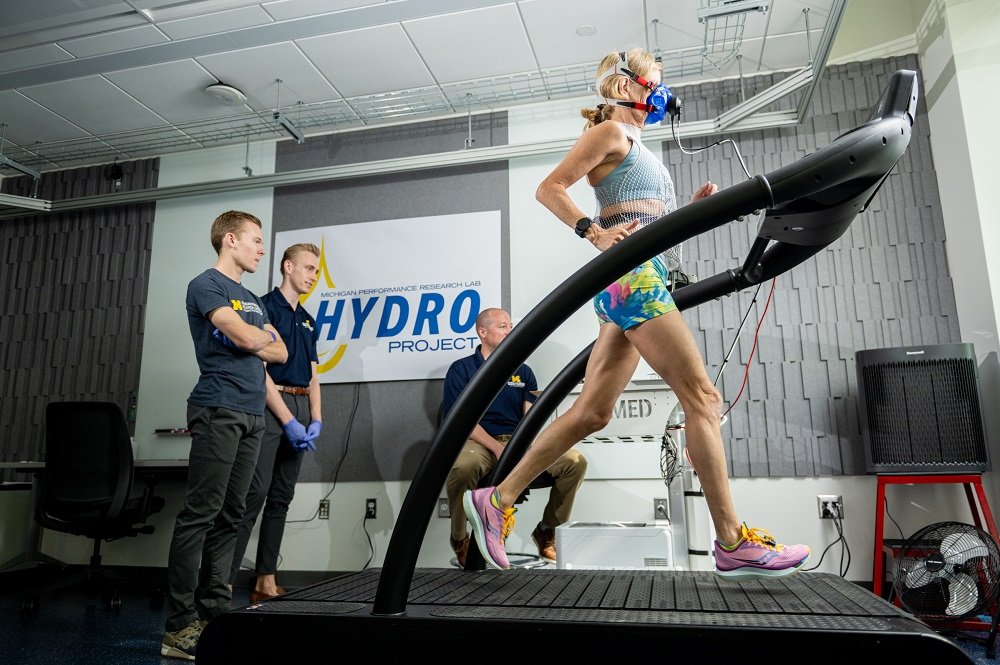Study to provide insights and learnings around sweat loss and VO2 max for runners by leveraging Galaxy Watch features
Samsung Electronics and the University of Michigan Exercise & Sport Science Initiative (ESSI) have launched a research partnership to explore smartwatch technology to help runners manage their health and physical activity by providing more reliable and accurate data.
The Michigan Performance Research Laboratory (MiPR) — ESSI’s core research lab — will oversee an eight-month study that uses the Galaxy Watch series to estimate the VO2 max and sweat loss of participants as they run. The study will compare reference data1 against smartwatch data from both indoor (treadmill) and outdoor running trials of different distances, from 2.5km to 20km.

Photo copyright: Regents of the University of Michigan. Eric Bronson/Michigan Photography
Runners at all levels grapple with sweat loss, dehydration and heat management, particularly during the summer months. Samsung and University of Michigan teams hope the study’s findings will further enhance smartwatch technology, giving runners more accurate measurements of their health metrics to help solve these issues.
Samsung chose the MiPR lab for this study given its established relationships within the wearable tech industry and running community, as well as the unique skill sets of its researchers. Co-PIs Adam Lepley, associate director – research; Alexandra DeJong Lempke, associate director – academics; and Ken Kozloff, co-director of ESSI, bring expertise in sports medicine, running-related injury, and performance, wearable tech, and applied/translational research. The ESSI MiPR lab has collaborated with the University of Michigan Athletic Department, multiple professional sports organizations, and industry leaders to derive meaningful insights from wearable technology that can be applied to sport and exercise.
“Samsung is committed to providing more meaningful health insights via our collaborations with industry leaders and academic institutions,” said Hon Pak, Vice President and Head of the Digital Health Team, MX Business at Samsung Electronics. “We are excited to partner with the University of Michigan’s Exercise & Sport Science Initiative — expert in the fields of fitness and sports health — in an effort to bring even more meaningful insights to those runners who rely on the Galaxy Watch series for accuracy and personalized motivation.”
“For the Michigan Performance Research Laboratory, the opportunity to work with Samsung, and leverage the advanced sensors and health and wellness trackers from one of the most popular smartwatches, gives added credibility to our research,” said Kozloff. “It’s exciting to participate in a study that positively impacts our community, and we’ve had an overwhelming response from subjects looking to learn more about themselves that they can apply to their training.”
Participant enrollment and data collection are already underway thanks to an enthusiastic response from local runners. “Ann Arbor is home to a robust running community, with community-based runners up to Olympic contenders,” Kozloff says.
The recently launched Samsung Galaxy Watch6 and Galaxy Watch6 Classic feature personalized fitness coaching, advanced sleep management and health monitoring to keep users motivated and focused on their goals.2 For runners, the new Personalized Heart Rate Zone feature3 provides five optimal running intensity levels based on individual physical capabilities, empowering them to set goals based on their own ability. Additionally, Track Run helps runners record their runs while on a running track. During a run, Galaxy Watch provides in-depth analysis including asymmetry, regularity and ground contact time to help improve performance and reduce injury.
1 Galaxy Watch’s VO2 max and sweat loss measurements were compared with CPET (Cardiopulmonary exercise testing) and weight change respectively.
2 Intended for general wellness and fitness purposes only. Not intended for use in detection, diagnosis, treatment, monitoring or management of any medical condition or disease. Any health-related information accessed through the device and/or application should not be treated as medical advice. Users should seek any medical advice from a physician. Certain features may vary by market, carrier, or the paired device.
3 To update the ranges of each Heart Rate zone for running based on cardiopulmonary capabilities, it is required to run outdoors more than 10 min with constant speed of 4km/h or faster.
This article was first published at Source link . You can check them out for other stuffs
